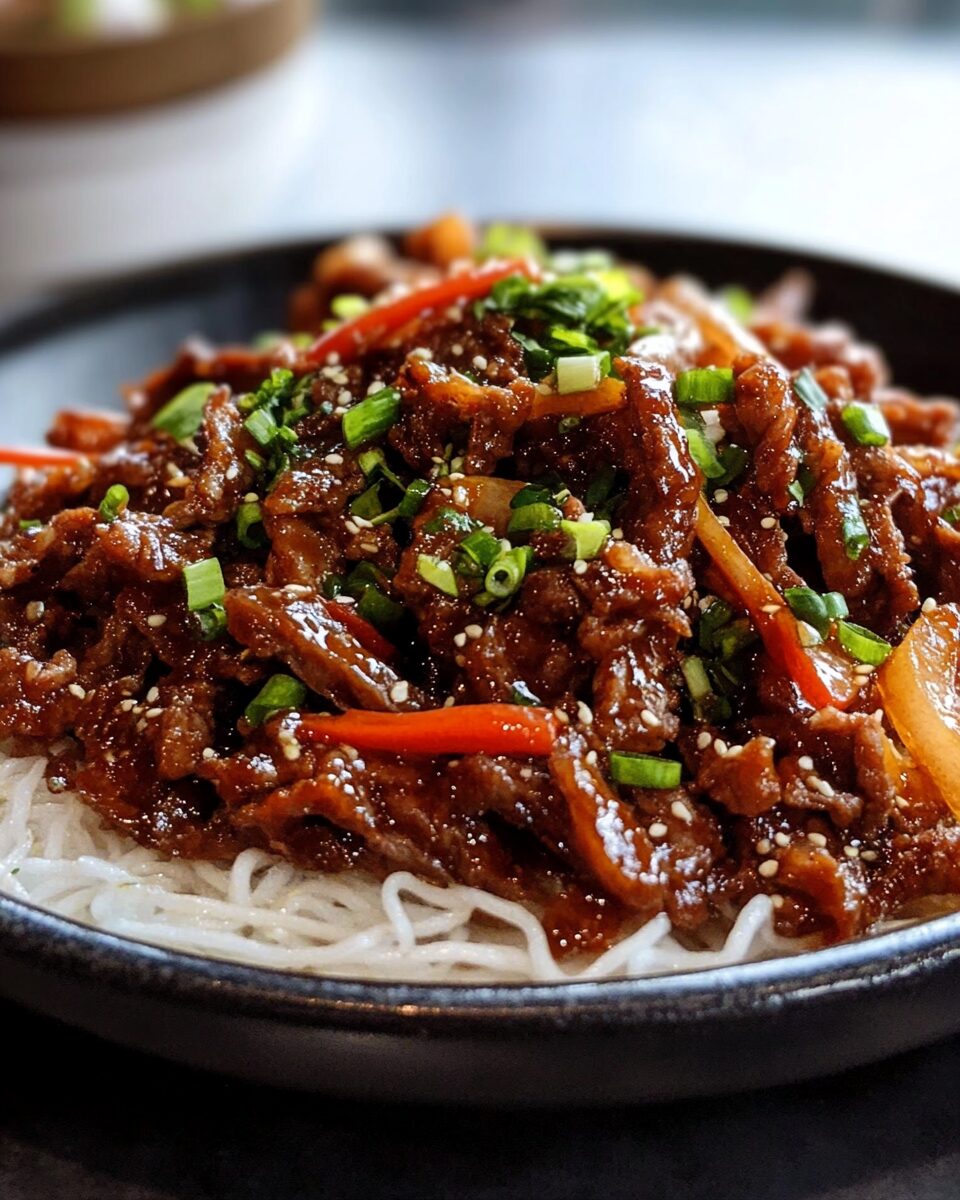The irresistible combination of crispy beef strips and a glossy, sweet-savory hoisin glaze makes this dish a favorite for anyone who loves bold, Chinese-inspired flavors. The contrast between the crunchy exterior and the tender meat inside creates a textural delight that’s as satisfying to eat as it is to prepare.
This homemade version of Peking Shredded Beef takes only 30 minutes from start to finish, making it a perfect weeknight dinner option. Serve it over steamed jasmine rice or toss it with stir-fried veggies for a restaurant-quality experience right in your own kitchen. It’s quick, impressive, and bursting with umami flavor!
Full Recipe:
-
500g (1 lb) beef steak (rump or sirloin), very thinly sliced
-
1 egg white
-
2 tbsp cornflour/cornstarch
-
1/2 cup vegetable oil (for shallow frying)
Sauce:
-
2 tbsp hoisin sauce
-
1 tbsp soy sauce
-
1 tbsp Chinese black vinegar (or rice vinegar)
-
2 tbsp brown sugar
-
2 tsp sesame oil
-
2 tsp ginger, freshly grated
-
1 garlic clove, finely minced
-
1 tsp chili flakes (optional, for heat)
Garnish:
-
1 green onion, finely sliced
-
1 tsp sesame seeds
Directions:
-
In a bowl, whisk the egg white until foamy, then mix in cornflour until smooth. Toss the sliced beef in the mixture to coat evenly. Let marinate for 10 minutes.
-
Heat oil in a wok or deep skillet over high heat. Shallow fry the beef in batches until crispy and golden. Remove and drain on paper towels.
-
Combine all sauce ingredients in a small saucepan and simmer over medium heat for 2-3 minutes until thickened.
-
Return the beef to the wok, pour over the sauce, and toss quickly to coat.
-
Serve immediately, garnished with sesame seeds and green onions.
Prep Time: 15 minutes | Cooking Time: 15 minutes | Total Time: 30 minutes
Kcal: 380 kcal | Servings: 4 servings
The Origins of Peking Shredded Beef
Peking Shredded Beef, often known as crispy shredded beef or sometimes referred to in Westernized menus as Beijing Beef, is a dish that embodies the essence of classic Chinese takeout fare. Though not a traditional Beijing dish in the historical sense, it borrows elements from northern Chinese cuisine, where the bold, savory, and sweet flavor profiles are popular. This dish gained mainstream popularity for its textural contrast—ultra-crispy beef coated in a glossy, sticky sauce—and has since become a beloved favorite in Chinese restaurants worldwide.
Its origins lie more in Chinese restaurant innovation than ancient culinary tradition, designed to appeal to Western tastes while showcasing signature Chinese techniques such as wok-frying and caramelizing sauces. Think of it as an evolution of sweet and sour pork or orange chicken, but upgraded with the rich umami depth of hoisin, soy, and aromatic spices.
Why Peking Shredded Beef is So Popular
There’s something universally satisfying about crispy textures and sweet-savory sauces. Peking Shredded Beef hits both marks with precision. Unlike stir-fries that may prioritize tenderness, this dish emphasizes crunch—thin strips of beef are marinated, coated in starch, and quickly fried to achieve that signature crispiness. Then they’re tossed in a sauce that’s both glossy and sticky, clinging to each strip for maximum flavor.
The flavor experience is both intense and harmonious. Hoisin provides depth and sweetness, soy sauce adds saltiness and umami, while ginger, garlic, and chili flakes offer aromatic complexity and a touch of heat. Combined with a slight tang from black vinegar, the overall result is addictive. It’s no surprise that this dish often disappears within minutes once served.
Another reason for its popularity is the ease with which it can be replicated at home. With just a handful of pantry staples and minimal prep time, it’s possible to achieve restaurant-quality results, especially with a hot wok or deep frying pan and the right slicing technique.
Texture Is Everything
What sets this dish apart isn’t just the sauce—it’s the interplay of textures. Achieving the perfect “crunch” is essential. The thinness of the beef is crucial; when sliced properly against the grain, the strips remain tender inside but crisp up beautifully on the outside during frying. The starch coating (usually cornflour or potato starch) forms a delicate crust that holds up even after being tossed in sauce.
What’s remarkable is that the dish retains its crunch even after being sauced—a rarity in fried foods. The secret lies in quick cooking: high heat frying, immediate draining, and a rapid toss in the thickened sauce. It’s a fast-paced dish that rewards precision.
The Role of the Sauce
The sauce is the heart of Peking Shredded Beef. It’s a symphony of flavors that transforms the crispy beef into something crave-worthy. Hoisin sauce gives it a rich sweetness and fermented depth. Soy sauce contributes saltiness and savoriness. Brown sugar balances the sharpness with caramel tones, while sesame oil rounds it out with nuttiness.
Black vinegar (or its substitute, rice vinegar) plays an important role—it adds a light acidity that balances the sweetness and cuts through the richness. Fresh ginger and garlic provide a sharp, aromatic contrast, making the entire dish more vibrant.
You can tailor the sauce to your taste, too—some like it spicier with more chili flakes, while others enjoy a subtler version that allows the hoisin to shine.
Choosing the Right Cut of Beef
The success of this dish hinges on the cut of beef you use. Rump steak or sirloin are great choices because they offer both flavor and tenderness. These cuts can be easily sliced thinly and remain juicy even after frying.
For best results, the beef should be partially frozen before slicing. This makes it easier to cut ultra-thin strips, which is critical for achieving the right balance between crispness and tenderness. Always slice against the grain—this shortens the muscle fibers, making the beef easier to chew.
Tips for Perfect Execution
While the recipe itself is straightforward, there are some pro tips that ensure restaurant-level results:
-
High Heat is Essential: Whether frying or saucing, high heat ensures rapid cooking and locks in flavor without sogginess.
-
Fry in Batches: Overcrowding the pan lowers the oil temperature, leading to soggy, oily beef. Fry in small batches for even crisping.
-
Drain Well: After frying, always let the beef rest on paper towels or a wire rack to remove excess oil.
-
Sauce Quickly: Don’t let the sauce sit in the pan too long. Once thickened, toss the beef in immediately to prevent burning or over-reduction.
-
Serve Immediately: This dish is best enjoyed fresh, while the beef is still crispy and the sauce is hot and glossy.
Serving Suggestions
Peking Shredded Beef is often served as part of a larger Chinese meal, but it can easily stand on its own as a main course. Steamed jasmine or basmati rice is a classic pairing—it absorbs the flavorful sauce and provides a soft contrast to the crisp beef.
For a more vegetable-forward plate, consider serving it alongside sautéed bok choy, stir-fried snow peas, or a cucumber salad with sesame dressing. The freshness and crunch of veggies pair beautifully with the richness of the beef.
Another great option is to use the beef as a filling in lettuce cups, which makes for a fun and lower-carb presentation—perfect for dinner parties or appetizers.
Variations to Explore
Like many Chinese-inspired dishes, Peking Shredded Beef is highly adaptable. Here are a few popular variations:
-
Spicy Version: Add extra chili flakes or a splash of chili oil to intensify the heat.
-
Orange or Mandarin Twist: Add a touch of orange zest and juice to the sauce for a citrusy brightness.
-
Vegetable Add-ins: Stir-fried onions, bell peppers, or julienned carrots can be tossed in with the beef for added texture and color.
-
Noodle Bowl: Serve the beef over a bowl of stir-fried noodles instead of rice for a comforting alternative.
You can also make it gluten-free by using tamari instead of soy sauce and ensuring your hoisin sauce is certified gluten-free.
Cultural Adaptation vs. Traditional Chinese Cuisine
While many people believe dishes like Peking Shredded Beef are directly sourced from ancient Chinese cooking, the reality is more nuanced. This dish represents a fusion between traditional techniques and Western flavor expectations.
Authentic Chinese dishes often emphasize balance, subtlety, and seasonal ingredients. However, Chinese-American and Western-Chinese cooking leans into bolder, more intense flavors—sugar, salt, and fat are more pronounced to appeal to a broader audience. That doesn’t make the dish any less valuable; instead, it showcases how adaptable and globally influential Chinese cooking can be.
Conclusion: A Dish Worth Mastering
Peking Shredded Beef is more than just a takeout favorite—it’s a showcase of texture, flavor, and simplicity. From its crispy golden strands to its glossy, umami-packed sauce, every bite is a lesson in culinary contrast. It proves that with a few pantry staples and thoughtful preparation, you can recreate restaurant-style meals at home with stunning results.
Whether you’re cooking for family, hosting a dinner party, or simply looking for a bold weeknight meal, this dish delivers every time. Its versatility, speed, and deeply satisfying flavors make it a recipe you’ll come back to again and again.





